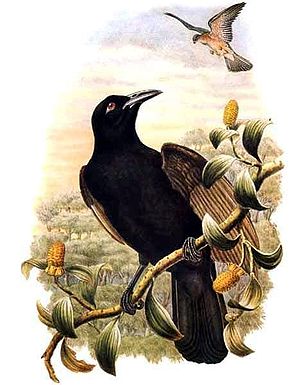Crow bird of paradise
| Crow bird of paradise | ||||||||||||
|---|---|---|---|---|---|---|---|---|---|---|---|---|

Crow Paradise Crow, depiction by Richard Bowdler Sharpe |
||||||||||||
| Systematics | ||||||||||||
|
||||||||||||
| Scientific name | ||||||||||||
| Lycocorax pyrrhopterus | ||||||||||||
| ( Bonaparte , 1851) |
The Paradise-crow ( Lycocorax pyrrhopterus ) is a crow similar -looking species from the family of birds of paradise (Paradisaeidae). It was long considered the only species of the genus Lycocorax , the obiparadise crow ( Lycocorax obiensis ) , which was previously treated as a subspecies, is now an independent species. The distribution area is the Moluccas. The species belongs to the few monogamous species of the birds of paradise. There are two subspecies.
The IUCN classifies the bird's paradise as safe ( least concern ).
description
The crow's bird of paradise is a medium-sized bird of paradise and reaches a body length of up to 42 centimeters, of which the largest subspecies, Lycocorax pyrrhopterus morotensis , is between 15.2 and 16.1 centimeters in the male and between 14.3 and 14.7 centimeters in the female on the control springs . The beak is 5.3 to 5.6 centimeters long. The sexes differ only slightly. The females are usually slightly smaller than the males.
The head is slightly shiny black-brown, with the vertex being the darkest. The coat, the back, the rump and the upper tail-coverts are a little lighter than the head. The upper plumage shines slightly, this blue-gray shimmer is most pronounced on the coat. The wings are dark brown, the wing covers have a darker tone, the wing feathers are dark cinnamon brown. The underside of the body is colored like the coat, although the tone on the lower abdomen, rump and tail-coverts is a little more brown. The beak is shiny black, the iris blood red.
Distribution area and habitat
The range of the bird of paradise are the Moluccas , an Indonesian group of islands between Sulawesi and New Guinea . A distinction is made between two subspecies that occur in the following regions of the Moluccas:
- Lycocorax pyrrhopterus morotensis Schlegel , 1863 : This subspecies occurs on the islands of Morotai and Rau of the Northern Moluccas .
- Lycocorax pyrrhopterus pyrrhopterus ( Bonaparte , 1850) ; This subspecies occurs on the islands of Halmahera , Kasiruta, and the Bacan Islands .
The altitude distribution ranges from the lowlands to altitudes of 1600 meters.
The bird of paradise occurs in a number of different habitats on the islands in its range. It colonizes both primary and secondary forests, occurs at the edges of forests and in overgrown gardens with many bushes. In the interior of rainforests, it is mostly found in the treetops of higher trees. It is comparatively rare in swampy forests, and it can only be found in mangroves if they border other forest types.
Way of life
The crow's bird of paradise is an inconspicuous, shy and secretly living bird of paradise. He lives mostly solitary or in pairs. It is only occasionally found in groups of up to five individuals. The flight is fast and direct and is often interrupted by gliding phases. When flying, a rustling of wings can be heard as an instrumental sound . The diet consists entirely of fruits.
Crows paradise birds are monogamous, both parent birds take care of the rearing of the young birds. The nest is erected 4 to 15 meters above the tree in a fork of a branch. The few nests investigated so far were bowl-shaped and built mainly from roots, wood particles and moss. The clutch consists of a single egg. The duration of the breeding season and the development of the young birds from hatching to escaping have not yet been documented.
literature
- Clifford B. Frith, Bruce M. Beehler : The Birds of Paradise - Paradisaeidae . Oxford University Press, Oxford 1998, ISBN 0-19-854853-2 .
Web links
- Lycocorax pyrrhopterus in the endangered Red List species the IUCN 2011. Posted by: BirdLife International, 2009. Accessed November 13, 2011th
Single receipts
- ↑ Handbook of the Birds of the World on Obiparadieskrähe , accessed on July 5, 2017
- ↑ a b c Handbook of the Birds of the World zum Krähenparadiesvogelf , accessed on July 4, 2017
- ↑ a b Frith & Beehler: The Birds of Paradise - Paradisaeidae . P. 207
- ↑ a b Frith & Beehler: The Birds of Paradise - Paradisaeidae . P. 205.
- ↑ a b Frith & Beehler: The Birds of Paradise - Paradisaeidae . P. 208.
- ↑ Frith & Beehler: The Birds of Paradise - Paradisaeidae . P. 209.